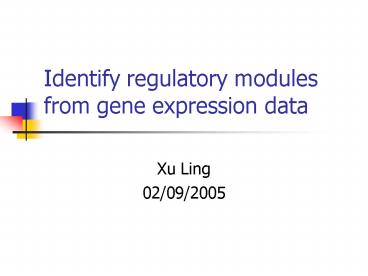Identify regulatory modules from gene expression data - PowerPoint PPT Presentation
1 / 14
Title:
Identify regulatory modules from gene expression data
Description:
Identifying this organization is crucial for understanding cellular responses to ... Motif Finding (AlignACE) putative regulatory elements (TFBSs) ... – PowerPoint PPT presentation
Number of Views:53
Avg rating:3.0/5.0
Title: Identify regulatory modules from gene expression data
1
Identify regulatory modules from gene expression
data
- Xu Ling
- 02/09/2005
2
Introduction
- Much of a cells activity is organized as a
network of interacting modules sets of genes
coregulated to respond to different conditions.
Identifying this organization is crucial for
understanding cellular responses to internal and
external signals. - Genome-wide expression profiles (e.g., DNA
microarray) provide important information about
regulatory mechanisms. - With the availability of complete genome
sequences, identifying cis-regulatory elements
via a bioinformatics approach on a genome-wide
manner comes out as a promising solution.
3
Tasks
- Whats the underlying mechanisms by which genes
are regulated? - Modules of coregulated genes?
- Regulators (transcription factors)?
- Regulation conditions (TFBSs/motifs, positional
and combinatorial constraints)?
4
General scheme (1)
- clustering-based approaches for finding motifs
from gene expression and sequence data
classify
5
General scheme (2)
- sequence(/knowledge)-based approaches for finding
motifs from gene expression and sequence data
6
General scheme (3)
- Comparative genomics has also been applied to
identify eukaryotic regulatory elements (e.g.,
Human-Mouse) because functional noncoding
sequences may be conserved across species from
evolutionary constraints. - Finding a good pair of species to compare and
choosing a good sequence conservation threshold
are critical and such information is not
available for most species.
7
Related work
- Predicting gene expression from sequence
- Michael A. Beer and Saeed Tavazoie
- Cell, 2004, 117 185-198
- A successful application of existing
computational approaches in studying the yeast
transcriptional regulation network
8
Approach
- Clustering (k-means) modules of coregulated
genes - Motif Finding (AlignACE) putative regulatory
elements (TFBSs) - Bayesian network learning regulation conditions
(motifs, positional and combinatorial constraints)
9
Bayesian Network
- Sequence features (x1,,xn) ? expression patterns
(ei) - Sequence feature (xi) presence of motifs,
positional constraints, and combinatorial
constraints - Expression pattern (ei) a binary one layer
network - Maximizing P(eix1,,xn), the probability that
genes with these sequence features will
participate in expression pattern i
10
Properties
- Easy to integrate all kinds of sequence features
- Explicit Sequence features
- To avoid complex networks overfit the training
data, a parameter for penalizing dense networks
is used. - Optimal network is greedily learned.
11
Motif finding approaches
- Explicit statistical modeling based
- Expectation maximization MEME,
- Gibbs Sampling AlignACE, Gibbs Motif sampler,
- Others CONSENSUS,
- word enumeration based MDscan,
12
MEME
- Sequence is broken up into all overlapping
subsequences of length W which it contains. - Two-component finite mixture model Motif (a
set of similar subsequences of fixed width)
Background (all other positions in the
sequences) - Motif model each example of the motif is assumed
to be generated by a sequence of independent,
multinomial random variables. - Background model each position (which is not
part of a motif) is generated independently by a
multinomial random variable. - Maximize the likelihood of the model M given the
data D L(MD)p(DM) by EM algorithm
13
Gibbs motif sampler
- Dealing with a specific model alignment rather
than a weighted average as EM does. - Iteratively sample motif models (or possibly
background model) for each subsequence and
thereby partition motif-encoding regions into
different motifs. - Iterative heuristic method, which combines
gradient search steps with random jumps in the
search space, hence not guaranteed to reach
optimal, but wont stuck at local maximums as EM
does. - Identify the most probable motif models by
locating the optimum alignments, which maximize
the ratios of the corresponding target
probabilities to the background probabilities
(MAP (maximum a posteriori) score).
14
Future work
- Ab initio motif finding approach from gene
expression and sequence data by attempting new
heuristic or statistic model. - Integrating prior knowledge (e.g., GO) to
facilitate identification of regulatory elements
and transcriptional network.






























